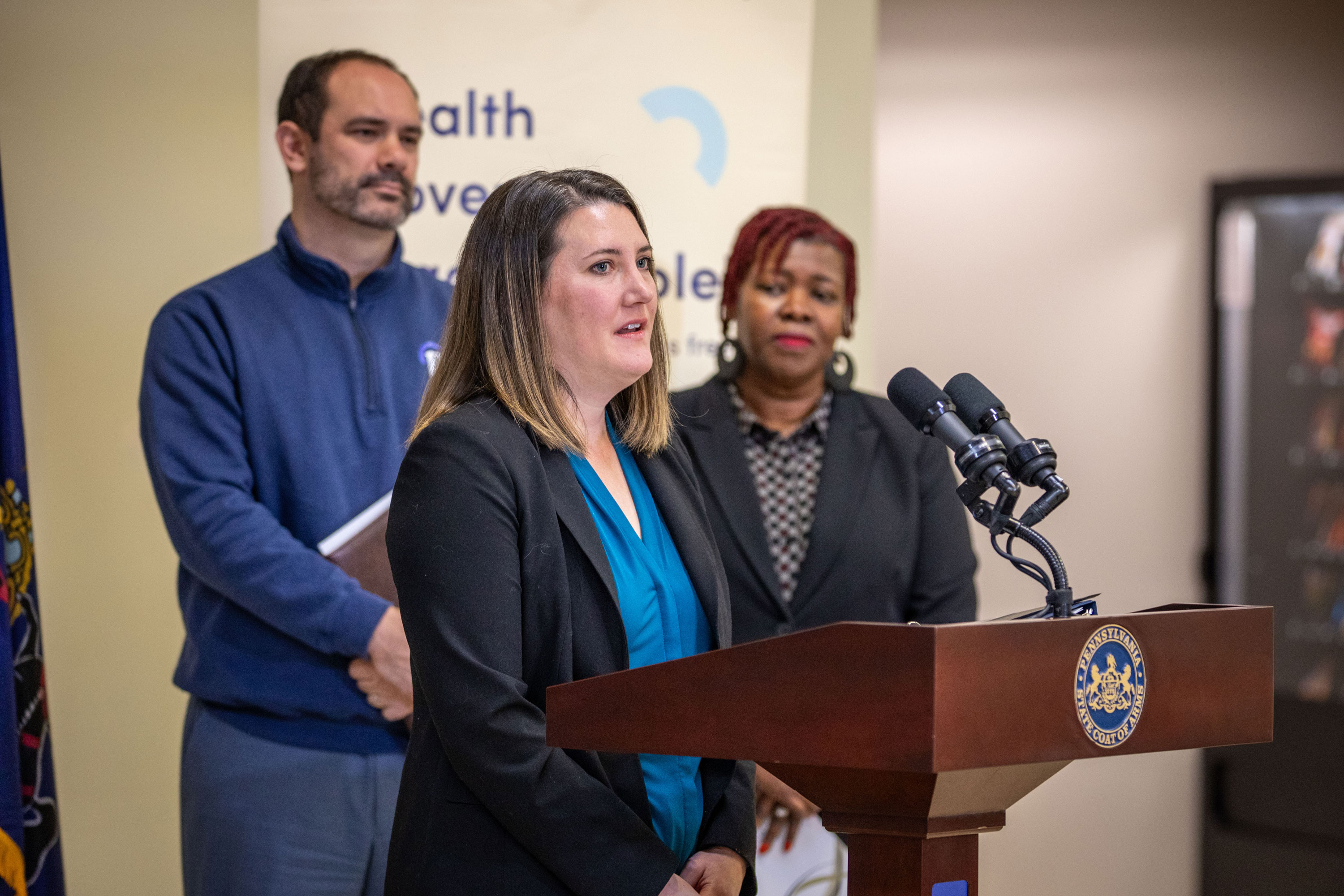Health Care
As open enrollment nears, Pennie looks to take the health care marketplace to the next level
The commonwealth’s health insurance marketplace continues to transform four years after the state took ownership from the federal government

Map of percent change in enrollments by county Pennie
With the Affordable Care Act once again an issue – thanks to Republican presidential candidate Donald Trump’s insistence that he has a “concept of a plan” on how he would repeal and replace the landmark health care legislation that has seen millions of Americans gain health insurance since its passage in 2010 – and with open enrollment season just days away, Pennsylvania’s health care exchange again finds its past, present and future in the spotlight.
The Pennsylvania Health Insurance Exchange Authority, the state-run health insurance marketplace – better known as Pennie – has been a game-changer for the commonwealth since being signed into law by then-Gov. Tom Wolf back in July 2019. The bipartisan legislation transitioned the commonwealth away from the federal Affordable Care Act insurance exchange and created its own version for the state to oversee and regulate.
Pennie, which was created to provide the opportunity for individuals and families who don’t have access to employer-sponsored health insurance or government-run coverage like Medicare or Medicaid, has allowed the commonwealth and its health partners to maintain local control and operation of customer service, reinsurance programs and more.
“We do, unfortunately, hear every day from people who want to enroll and it’s just too much for them to get that coverage,” Devon Trolley, executive director of Pennie, told City & State. “We want to continue tailoring programs to Pennsylvanians, being responsive to concerns we’re hearing, and building on the networks and resources across Pennsylvania to do that.”
By establishing Pennie, the state can offer access to health insurance products from private insurers. As of 2022 – the most recent year such statistics were available – Pennsylvania ranked ninth in the country for the lowest uninsured rate, with 5.4% of its population lacking health insurance. Fourteen insurers offered coverage for 2024, including Jefferson Health Plans; with Cigna dropping out of the exchange after this year, there will be 13 insurers statewide in 2025.
As the market and insurers continue to change, individuals at the state and community-based organization level are hoping more targeted outreach and education efforts can connect people to the care they need.
Market makeup
One region in particular – Southeastern Pennsylvania, which includes Philadelphia – has seen plans and providers shift since the Pennie marketplace first opened. Independence Blue Cross, the lone insurer offering ACA plans since 2017 following Aetna’s exit from the region, now has competition from Highmark and Thomas Jefferson. (The region will have eight insurers heading into 2025.)
Highmark, a Blue Cross Blue Shield company based in Pittsburgh that is the only insurer to offer ACA plans statewide, is competing with IBX to sell group plans to employers in Southeastern Pennsylvania. Jefferson, which acquired control of Health Partners Plans in 2021 and is set to acquire Lehigh Valley Health Network, is a nonprofit insurer that also sells Medicare Advantage plans and is working in the region.
The new entrants also mark the first time two Blue-branded health insurers will go head-to-head to compete for commercial members.

And while outcomes from the more competitive market will only be revealed in time, those in the health care space are encouraged by the diversity of offerings consumers now have.
“At least in my experience, when other new insurers have come out, it takes a while – both for consumers and entities – to accept that insurance,” Jenn Lydic, director of social services and community engagement at the Public Health Management Corporation, a nonprofit that runs six health centers in Philadelphia, told City & State.
The end of the COVID-19 public health emergency last year contributed to the strong growth in Pennie’s open enrollment totals. Since then, state Medicaid agencies have been required to resume verifying individuals’ qualifications for Medicaid.
The number of people with Medicaid in Southeastern Pennsylvania fell 12%, to 927,592 in February from 1,057,708 just 12 months earlier. Some people moved to Pennie plans, which can be heavily subsidized for lower-income individuals who don’t qualify for Medicaid.
“I think Pennie has been doing a really good job of working with community-based organizations to get information out there to people – particularly for small business
people who have issues with affordability and accessing health care,” state Sen. Sharif Street, minority chair of the Senate Banking & Insurance Committee, told City & State. “Pennie has made a significant impact in ensuring those folks have access.”
Since Pennie began operating in 2020, when the commonwealth took over ownership and operation from the federal marketplace, enrollment has increased by more than 150,000 – a 56% increase in the number of people covered through the exchange.
Enrollment data from Pennie, while limited to the open enrollment period that ended in January 2024, shows a significant bump in signups year-over-year. Pennie recorded a record-breaking number of enrollees – nearly 435,000 – during open enrollment to kick off 2024, a 17% increase compared to the previous year, far exceeding the average annual increase of 1% in previous open enrollment periods.
Trolley said Pennie not only acts as a resource for those looking for health insurance information, but also as a hub for comparing plans that consumers can trust.
“We really are kind of agnostic to the insurers. What we’ve heard from consumers is that they like having options,” Trolley said. “We often hear, too, that people aren’t sure where to go to compare plans from different insurers. So that’s another thing we really try to communicate: Pennie is an objective source of information about what plans are available.”

One of the community-based organizations helping people navigate the system is the Philadelphia Health Access Network, which advocates for and assists people in the benefits system. Joanna Rosenhein, a consumer engagement manager with PHAN, said while Pennie has the tools in place to help individuals navigate enrollment easier, there is always room for improvement.
“Pennie has a tool that makes it so that folks can sift through their plan options … adjusting that tool a little bit to make it easier for folks to understand what benefits specifically are being offered with each plan and then the meaning behind those benefits,” Rosenhein told City & State. “I think there’s some education that can be done on Pennie to let folks know more about what specific cost sharing terms mean – that can be a big barrier for people.”
Commonwealth coverage
The increase in Pennie enrollment also comes at a time when the commonwealth’s largest city and surrounding counties have more options than ever before.
Pennie leaders have emphasized their focus on the region, and signups indicate the efforts are beginning to pay off. County data shows that Philadelphia accounts for more than 51,000 enrollees – a number that jibes with the city representing almost 12% of the state’s population (the collar counties of Delaware, Montgomery and Bucks counties have recorded about 21,000, 32,000 and 28,000 enrollees, respectively).
Looking ahead, Trolley said the state’s reinsurance program, as well as efforts at the state and federal levels to provide subsidies to help individuals pay for premiums, would all go a long way toward reducing costs and expanding coverage. And on top of a new affordability program that could benefit consumers going into 2025, Pennie continues to work on health literacy and enrollment assistance initiatives.
Those in the insurance space agree that accessibility and affordability remain top priorities now and going forward, especially since insurers are looking to increase the prices of their coverage plans in 2025, which could raise monthly premium costs for people who buy plans through ACA marketplaces like Pennie.

Pennie “really has been invaluable for some of our higher-income earners who maybe don’t qualify for Medicaid for other reasons,” Lydic said, noting the work PHMC does in assisting individuals to navigate and sign up for health coverage in the marketplace. “Applying for public benefits and applying for insurance and navigating insurance is often tricky and confusing. We know that for folks who are insured, they’re more likely to take care of their preventative health care needs and go to the doctor more frequently, so that’s why we find benefit access so important.”
Rosenhein expressed similar sentiments, adding that Pennie has been valuable to lawfully present immigrants who surpass the five-year bar to qualify for Medicaid. Any additional support for those who aren’t familiar with the system or speak English as a second language, she said, could go a long way toward ensuring more individuals are able to access and enroll in the system.
Pennie has been a “huge safeguard” for those communities, Rosenhein said.
“For those folks, Pennie is a great program because they can get potentially the full financial assistance and they’re not barred from enrolling in Pennie because of their immigration status,” she added. “It’s hard to reach those populations and (have them) really trust the system. That’s why it’s important to have assisters and (have them) work with community based organizations who are directly working with these communities to inform them of their options. We do some of that work across the state, but we know that there’s definitely a lot more that needs to be done.”
Open enrollment 2025 begins on Nov. 1, with Dec. 15 being the deadline for coverage that begins Jan. 1 and Jan. 15, 2025, the deadline for 2025 health coverage for coverage that begins Feb. 1, 2025.
